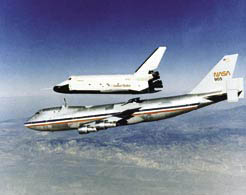1.3 SHUTTLE DEVELOPMENT, TESTING, AND QUALIFICATION
1.3 Shuttle Development, Testing, and Qualification
―シャトルの開発・テスト・適正証明―
―シャトルの開発・テスト・適正証明―
The Space Shuttle was subjected to a variety of tests before its first flight. However, NASA conducted these tests some-what differently than it had for previous spacecraft.*8 The Space Shuttle Program philosophy was to ground-test key hardware elements such as the main engines, Solid Rocket Boosters, External Tank, and Orbiter separately and to use analytical models, not flight testing, to certify the integrated Space Shuttle system. During the Approach and Landing Tests (see Figure 1.3-1), crews verified that the Orbiter could successfully fly at low speeds and land safely; however, the Space Shuttle was not flown on an unmanned orbital test flight prior to its first mission ュ a significant change in phi-losophy compared to that of earlier American spacecraft.
スペースシャトルは最初の飛行までに、数々のテストを受けなければなりませんでした。しかし、NASAはそれらのテストを、これまでの宇宙船とは少し違う方法で行いました*8。スペースシャトルプログラムでは、次のようなポリシーで開発が行われたのです。カギとなるハードウエア―メインエンジンや固体燃料ロケット、外部燃料タンク、オービターなど―はそれぞれ別々に地上でテストされ、飛行テストではなく分析的なモデルを用いてテスト結果を承認し、スペースシャトルシステム全体へと統合する。アプローチ/着陸テスト(図1-3-1参照)において、乗員はオービターがゆっくりとしたスピードで飛行でき、安全に着陸できることを確かめました。しかし、スペースシャトルはその最初の飛行まで、衛星軌道への無人のテスト飛行は行われなかったのです。これは、初期のアメリカの宇宙船の開発ポリシーとはまったく違うやり方です。

Figure 1.3-1. The first Orbiter was Enterprise, shown here being released from the Boeing 747 Shuttle Carrier Aircraft during the Approach and Landing Tests at Edwards Air Force Base.
図1-3-1:最初のオービターはエンタープライズでした。
ここでは、ボーイング747シャトルキャリアから切り離され、
エドワーズ空軍基地へのアプローチと着陸のテストを行っています。
ここでは、ボーイング747シャトルキャリアから切り離され、
エドワーズ空軍基地へのアプローチと着陸のテストを行っています。
The significant advances in technology that the Shuttles design depended on led its development to run behind schedule. The date for the first Space Shuttle launch slipped from March 1978 to 1979, then to 1980, and finally to the spring of 1981. One historian has attributed one year of this delay "to budget cuts, a second year to problems with the main engines, and a third year to problems with the thermal protection tiles."*9 Because of these difficulties, in 1979 the program underwent an exhaustive White House review. The program was thought to be a billion dollars over budget, and President Jimmy Carter wanted to make sure that it was worth continuing. A key factor in the White Houses final assessment was that the Shuttle was needed to launch the intelligence satellites required for verification of the SALT II arms control treaty, a top Carter Administration priority. The review reaffirmed the need for the Space Shuttle, and with continued White House and Congressional support, the path was clear for its transition from development to flight. NASA ultimately completed Shuttle development for only 15 percent more than its projected cost, a comparatively small cost overrun for so complex a program.*10
シャトルの設計が、重要な技術的進歩に依存していたために、開発スケジュールは遅れていきました。最初のスペースシャトルの打上げは、1978年3月から1979年にずれ込み、さらに1980年になり、最終的には1981年の春になりました。ある歴史家はこの遅れについてこう述べています。「1年目の遅れは予算カットのため、2年目はメインエンジンの問題、3年目は耐熱タイルの問題から生じた」*9 これらの問題点のために、1979年にプログラムはホワイトハウスの厳しい審議の対象となります。プログラムは100万ドルの予算超過になるだろうと考えられました。そこで、ジミー・カーター大統領は、プログラムを継続する価値があるかどうかを確かめることを求めました。ホワイトハウスの最終的な評価のカギとなったのは、SALT IIの軍縮条約の実行を確認するスパイ衛星の打ち上げにシャトルが必要だという事実でした。これはカーター政権の最重要事項だったのです。この評価はスペースシャトルの必要性を再確認するものであり、ホワイトハウスと議会の支持が続くことを示していました。これによって、シャトルが開発段階から実際の飛行へと移行する道が開かれたのです。NASAは最終的に予定された予算を15%超過してシャトルを完成させました。これは、これほどの複雑なプログラムにしては、比較的わずかな超過といえるでしょう。
The Orbiter that was destined to be the first to fly into space was Columbia. In early 1979, NASA was beginning to feel the pressure of being behind schedule. Despite the fact that only 24,000 of the 30,000 Thermal Protection System tiles had been installed, NASA decided to fly Columbia from the manufacturing plant in Palmdale, California, to the Kennedy Space Center in March 1979. The rest of the tiles would be installed in Florida, thus allowing NASA to maintain the appearance of Columbias scheduled launch date. Problems with the main engines and the tiles were to leave Columbia grounded for two more years.
最初に宇宙に行くオービターはコロンビアでした。1979年の初め頃から、NASAはスケジュールの遅れに対するプレッシャーを感じ始めました。30,000枚貼られるはずの耐熱タイルが24,000枚しか作業が終わっていないにもかかわらず、NASAは1979年の5月にコロンビアをカルフォルニア州パームデールの組立工場からケネディ宇宙センターへシャトルを空輸することを決めました。残りのタイルをフロリダで貼ることで、NASAはコロンビアを打上げに間に合わせたのです。しかし、メインエンジンとタイルの問題はさらに2年間コロンビアを地上に留めることになりました。